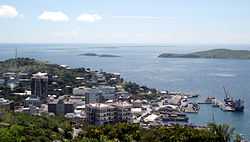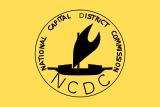Port Moresby
| Port Moresby Pot Mosbi | ||
|---|---|---|
|
Downtown Port Moresby | ||
| ||
 Port Moresby Location within Papua New Guinea | ||
| Coordinates: 9°30′49.1″S 147°13′7.7″E / 9.513639°S 147.218806°E | ||
| Country |
| |
| Division | National Capital District | |
| Established | 1873 | |
| Government | ||
| • Governor | Powes Parkop (2007-) | |
| Area | ||
| • Total | 240 km2 (90 sq mi) | |
| Elevation | 35 m (115 ft) | |
| Population (2011 census) | ||
| • Total | 364,125 | |
| • Density | 1,500/km2 (3,900/sq mi) | |
| Languages | ||
| • Main languages | Motu, Tok Pisin, English | |
| Time zone | AEST (UTC+10) | |
| Postal code | 111 | |
| Website |
www | |
Port Moresby (/ˌpɔərt ˈmɔərzbi/; Tok Pisin: Pot Mosbi) is the capital and largest city of Papua New Guinea (PNG). It is located on the shores of the Gulf of Papua, on the southeastern coast of the Papuan Peninsula of the island of New Guinea. The city emerged as a trade centre in second half of the 19th century. During World War II it was a prime objective for conquest by the Imperial Japanese forces during 1942–43 as a staging point and air base to cut off Australia from Southeast Asia and the Americas.
In 2000 it had a population of 254,158.[1] As of 2011 it has a population of 364,145, giving it an annual growth rate of 2.1% over a nine-year period. The place where the city was founded has been inhabited by the Motu-Koitabu people for centuries. The first European to see it was Captain John Moresby in 1873. It was named in honour of his father, Admiral Sir Fairfax Moresby.
According to a survey of world cities by the Intelligence Unit of The Economist, Port Moresby is one of the world's least livable cities (ranked 139 of 140 cities rated).[2]
Although Port Moresby is surrounded by Central Province, of which it is also the capital, it is not part of that province, but forms the National Capital District.
History

Before colonisation
The Motuan people of the area now known as Port Moresby traded their pots for sago, other food and canoe logs, sailing from Hanuabada and other villages built on stilts above the waters of the bay. Their language, Motu, was the basis of Hiri Motu, an official language of Papua New Guinea though it has been steadily in decline since the 1960s when Tok Pisin, till then confined to the northern side of the former border between Papua, British New Guinea until 1905, and New Guinea, that was German New Guinea until 1914.
The Hiri expeditions were large-scale. As many as 20 multi-hulled canoes or lakatoi, crewed by some 600 men, carried about 20,000 clay pots on each journey. To the Motuans, not only was the Hiri an economic enterprise but it also confirmed their tribal identity through its long and dangerous voyages.
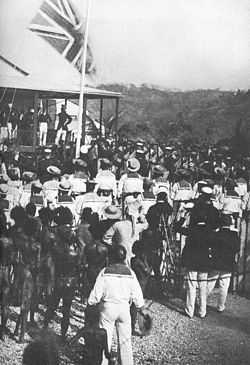
Colonisation

There was already an important trade centre on the site of Port Moresby when the English Captain John Moresby of HMS Basilisk first visited it. He sailed through the Coral Sea at the eastern end of New Guinea, saw three previously unknown islands, and landed there. At 10 a.m. on 20 February 1873, he claimed the land for Britain and named it after his father, Admiral Sir Fairfax Moresby. He called the inner reach "Fairfax Harbour" and the other Port Moresby.

No Europeans settled there until ten years later, when the southeastern part of New Guinea was annexed to the British Empire by the Colony of Queensland. Administration of British New Guinea was transferred to the newly established Commonwealth of Australia in 1906, the federation of the colonies on Australia and Tasmania having occurred 1 January 1901, though only to administer it: Australia did not accept the sovereignty granted to the dominions of the British Empire by the Statute of Westminster 1931 until the Statute of Westminster Adoption Act 1942[4] and British New Guinea therefore did not become a colony of the federated colony of Australia. Australia did, however, rename it as Papua. From then until 1941 Port Moresby grew slowly. The main growth was on the peninsula, where port facilities and other services were gradually improved. The first butcher's shop and grocery opened in 1909,[5] electricity was introduced in 1925,[6] and piped water supply provided in 1941.[7]
World War II and after


During World War II, some Papuan men enlisted in the Papua Infantry Battalion, and others as carriers over trails and rough terrains (porters) as supply support to Allied and Japanese armies during long jungle marches.[8] The biographer of General Douglas MacArthur, historian William Manchester, makes it plain in his biography of the General, American Caesar, that acting as porters was well down the natives' list of acceptable voluntary activities and that they would fade away without great inducements.[9] Many Papuan residents of Port Moresby either returned to their family villages or were evacuated to camps when the threat of Japanese invasion loomed. The city became, by September 1942, home to an important Allied complex of bases and thousands of troops were eventually stationed in the area or more often, staged through it, as it was the last Allied bastion on the island[10][11] and conversely, a key staging and jumping off point as the Allies began conducting offensive warfare themselves, pushing back the Japanese advances.[12]
In 1945, the Territory of Papua and New Guinea was formed when Papua and the former German New Guinea, which had been administered by Australia since 1918, were amalgamated under a single Australian administration though several laws remained in two territories and remain so, which can be complicating with provinces sitting on two sides of the otherwise extinct boundary. Port Moresby became the capital of the new combined territory and a focal point for the expansion of public services.
-

The longstanding downtown United Church with next door office building in 2013 were replaced with one building, the church on the ground floor
-

Looking past Pacific Place showing building beneath it which will block the view of the harbour from the street
-

Port Moresby's Roman Catholic cathedral remains downtown though parishioners largely come from elsewhere in the city
-

The current Anglican cathedral replaces the building dating back to the first part of the 20th century
-

The long ceased to do business Burns Philp department store, in the mid-90s having been used as a private school building
-

Office and apartment tower on Ela Beach at the bottom of Musgrave Street
Independence
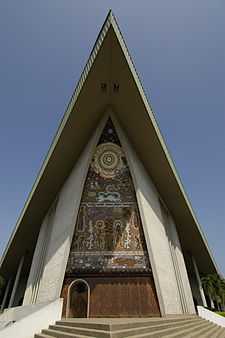
In September 1975, Papua New Guinea became an independent country with Port Moresby as its capital city. Prince Charles, Prince of Wales, represented the Queen of Papua New Guinea at the celebrations.[13] New government, intellectual and cultural buildings were constructed in the suburb of Waigani to supplement and replace those of downtown Port Moresby. They included those for government departments, including a National Parliament Building, which was opened in 1984 by Prince Charles and blends traditional design with modern building technology.[13]
The PNG National Museum and National Library are also located at Waigani. A mansion was built in Port Moresby just west of the old legislative building but the last pre-independence chief minister and first prime minister of the sovereign state declared it not nearly grand enough; it was made the residence of Australian high commissioners and a mansion suitable to Somare's demands was built in Waigani.
-

National library and archives in Waigani in 2013
-
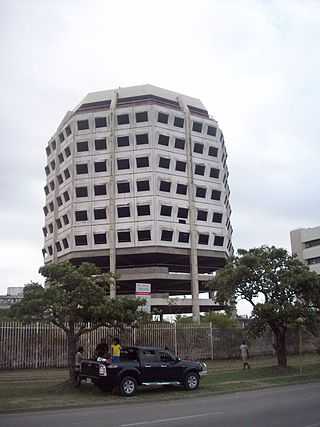
Pineapple Building being restored in 2013 after many years of being abandoned
-

Old courthouse in downtown Port Moresby still bearing its original sign
-

PNG National Court building in Waigani, in 2013 with substantial repair and enlargement with additional wing
Several of the government buildings have now been abandoned due to long-term neglect. Chief amongst these are Marea Haus (known to most locals as the "Pineapple Building") and the Central Government Offices. Nearby buildings, such as Morauta Haus and Vulupindi Haus, are now starting to show significant signs of decay due to a lack of maintenance. However, widespread restoration rather than demolition of long-disused office buildings has been highly active since the first decade of the 21st century. The legislative building before independence and the first parliament building is long-gone but the old court house in town Port Moresby remains, indeed still bearing its pre-independence label with its previous title.
The population of the Port Moresby area expanded rapidly after independence. In 1980 the census registered 120,000; by 1990, this had increased to 195,000.
Climate
Port Moresby has a tropical wet and dry climate with relatively constant temperatures throughout the year. The wet season starts in December and ends in May; the dry season covers the remaining six months. Port Moresby's average yearly rainfall is just over 1,000 mm (39.4 in). Average daily high temperatures range from 28 to 32 °C (82 to 90 °F) depending on time of year, while the average low temperature shows very little seasonal variation, hovering around the 26 °C (79 °F) mark. It tends to be slightly cooler in the city during the dry season.
| Climate data for Port Moresby, Papua New Guinea | |||||||||||||
|---|---|---|---|---|---|---|---|---|---|---|---|---|---|
| Month | Jan | Feb | Mar | Apr | May | Jun | Jul | Aug | Sep | Oct | Nov | Dec | Year |
| Record high °C (°F) | 37 (99) |
36 (97) |
36 (97) |
36 (97) |
34 (93) |
33 (91) |
32 (90) |
32 (90) |
34 (93) |
34 (93) |
36 (97) |
36 (97) |
37 (99) |
| Average high °C (°F) | 32 (90) |
31 (88) |
31 (88) |
31 (88) |
30 (86) |
29 (84) |
28 (82) |
28 (82) |
29 (84) |
30 (86) |
31 (88) |
32 (90) |
30 (86) |
| Average low °C (°F) | 26 (79) |
26 (79) |
26 (79) |
26 (79) |
26 (79) |
25 (77) |
25 (77) |
25 (77) |
25 (77) |
26 (79) |
26 (79) |
26 (79) |
26 (79) |
| Record low °C (°F) | 23 (73) |
23 (73) |
23 (73) |
22 (72) |
22 (72) |
22 (72) |
20 (68) |
20 (68) |
21 (70) |
21 (70) |
22 (72) |
23 (73) |
20 (68) |
| Average precipitation mm (inches) | 178 (7.01) |
193 (7.6) |
170 (6.69) |
107 (4.21) |
64 (2.52) |
33 (1.3) |
28 (1.1) |
18 (0.71) |
25 (0.98) |
36 (1.42) |
48 (1.89) |
112 (4.41) |
1,012 (39.84) |
| Source: http://www.bbc.co.uk/weather/world/city_guides/results.shtml?tt=TT003090 | |||||||||||||
Regions and suburbs

-

Walter Bay from hills immediately east of downtown Port Moresby
-

Koki neighbourhood
-
Ela Beach
-
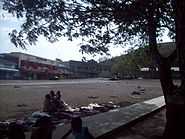
Streets and buildings in Boroko 2013
Port Moresby refers to both the urbanised area of the National Capital District and more specifically to the main business area, known locally as "Town". Since the 1990s the original town centre has ceased to have restaurants and night life, though it is very successful and prosperous looking as an office centre; the affluent housing region north of downtown along and up from the coach remains so, though there are now few modest residential houses, most of which are replaced with substantial mansions and apartment buildings. The suburb of Boroko, once the commercial heart of Port Moresby, is currently very idle, with many former shopping buildings now simply empty; to the west of there, however, is full of high rises, shopping centres and affluent housing. Other neighbourhoods of Port Moresby include: Koki, with its popular fresh produce market, Newtown, Konedobu, Kaevaga, Badili, Gabutu, Kila Kila, Matirogo, Three Mile, Kaugere, Sabama, Korobosea, Four Mile, Hohola, Hohola North, Boroko, once a major shopping area, Gordons, Gordons North, Erima, Saraga, Waigani, Morata and Gerehu. There are also villages like Hanuabada, the largest village in Papua New Guinea. All parts of Port Moresby have serious security problems with violent attacks by criminals, causing fences and walls to be considered necessary around houses and apartment buildings and security guards to be widely employed. The UN Global Compact Cities Programme, using a method called Circles of Sustainability has assessed the urban security of Port Moresby as 'critical'.[14]
Transport

Port Moresby is served within the city by buses and privately owned taxis. Flights are vital for transport about the country, highways not being widely available. Port Moresby is served by Jacksons International Airport, the biggest international airport and Papua New Guinea Defence Force Air Wing base in the country. Air Niugini and Airlines PNG both conduct regular domestic and international services from the airport, while Virgin Australia flies to Brisbane. Jacksons has international flights to Brisbane, Cairns, Cebu, Sydney, Honiara, Nadi, Manila, Singapore, Hong Kong and Tokyo.
As the national highway system is not fully linked, there are many internal flights to other towns, e.g. Madang, which cannot be reached by ground transport, such as minibuses, known locally as PMVs (Public Motor Vehicles).
Economy

Airlines PNG has its head office on the grounds of Jacksons International Airport in Port Moresby.[15] In recent years Port Moresby has been economically booming. There has been substantial building of housing, office towers and commercial establishments over much of it, apart from the once significant but currently vastly depressed Boroko.
Twin towns
 Jinan, People's Republic of China (Province Shandong) since 28 September 1988
Jinan, People's Republic of China (Province Shandong) since 28 September 1988 Palm Desert, United States (California)
Palm Desert, United States (California) Townsville, Australia (Queensland) since 1983
Townsville, Australia (Queensland) since 1983
Associated town:
References
- ↑ "citypopulation.de". citypopulation.de. Retrieved 2010-04-25.
- ↑ Dowling, Jason (15 August 2012). "Melbourne again most liveable city". The Age. Retrieved 15 August 2012.
- ↑ Its modesty -- still used today though substantially enlarged and altered -- demonstrates how plain in lifestyle the British and then Australians were compared with the ostentatious Germans of the period.
- ↑ As New Zealand did not until the Statute of Westminster Adoption Act 1947.
- ↑ "March of Civilisation". The Argus (The Argus Office, Melbourne Victoria). 7 September 1909. p. 5. Retrieved 29 November 2009.
- ↑ "Progress in Papua". The Argus (The Argus Office, Melbourne Victoria). 5 September 1925. p. 12. Retrieved 29 November 2009.
- ↑ "Department of the Interior: Tenders". The Argus (The Argus Office, Melbourne Victoria). 25 January 1941. p. 18. Retrieved 29 November 2009.
- ↑ "Australian War Memorial - AJRP Essays". Ajrp.awm.gov.au. Retrieved 2010-04-25.
- ↑ American Caesar, William Manchester, 1978, Little Brown Company,793 pages, ISBN 0-316-54498-1, pp.306: On and about Jul-Sep 1942 and MacArthur's troops stop the Japanese in the difficult jungles of New Guinea and General Kenney gifts Port Moresby to the SAC by moving the bomber line 1800 miles to five new air bases.
- ↑ "Amazon.com listing for the "Four Corners: A Journey into the Heart of Papua New Guinea"".
- ↑ Salak, Kira. "Nonfiction book about Papua New Guinea,"Four Corners"".
- ↑ American Caesar, William Manchester, 1978, Little Brown Company,793 pages, ISBN 0-316-54498-1, pp.290-307: On and about Feb-Dec 1942 and MacArthur's reorganization of troops, lack of theater priority, his support for Guadalcanal and his daring offensive gamble in going to meet the Japanese in the difficult jungles of New Guinea as a way of conducting a forward defense of Australia, rather than risk a war of maneuver when he had insufficient forces to move around.
- ↑ 13.0 13.1 "Prince of Wales and Duchess of Cornwall to make Australian visit", The Telegraph, 19 September 2012, retrieved 21 September 2012
- ↑ James, Paul; Nadarajah, Yaso; Haive, Karen; Stead, Victoria (2012). pdf download Sustainable Communities, Sustainable Development: Other Paths for Papua New Guinea. Honolulu: University of Hawaii Press.
- ↑ "APNG Contacts." Airlines PNG. Retrieved on 26 May 2010.
Further reading
- James, Paul. et al., Sustainable Communities, Sustainable Development: Other Paths for Papua New Guinea (2012)
External links
| Wikimedia Commons has media related to Port Moresby. |
| ||||||||||
| ||||||||
| ||||||||||||||||||||||||||||||
| |||||||||||||||||||||||||
